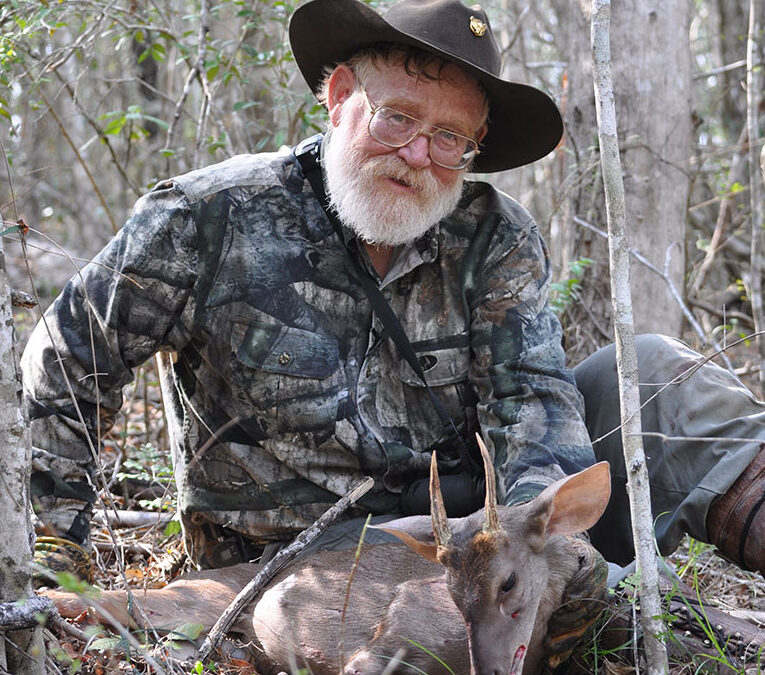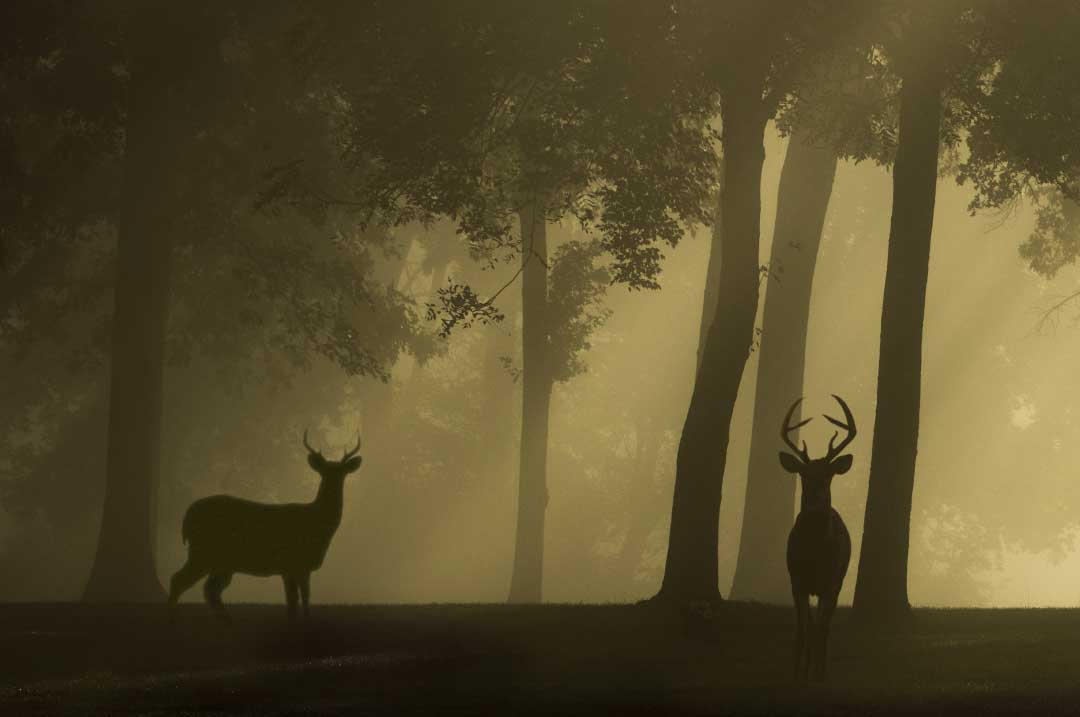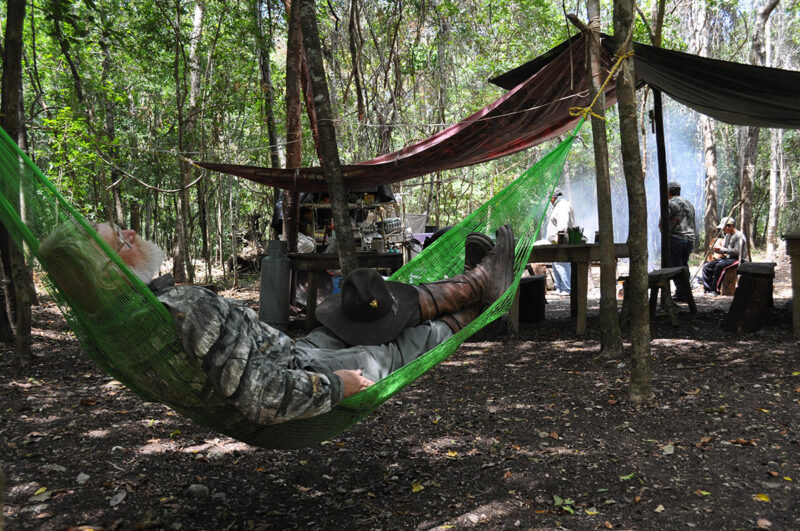
Larry relaxes in camp while hunting brocket deer in Campeche.
I laid on my cot relaxing after having consumed easily a full pound of grilled beef fajitas, fresh vegetables and some of the best tortillas I had ever tasted. I closed my eyes and in spite of the heat and humidity drifted to dreamland, a land populated with ancient Mayans….
Somewhere way off in the distance I heard a voice… “Es hora de cazar!” I was about to shake off the noise as the voice of a spirit, knowing we were camped in the midst of an ancient Mayan settlement, then I heard another voice, one more familiar and shook the cobwebs of sleep. I realized Ariel Trevino, my Mexico hunting partner, fellow wildlife biologist and amigo said, “Hay que apurarse, para llegar al area de caza.” Although I do not speak Spanish, I understood enough from years of living in Brush Country of South Texas, which I often referred to as “Upper Tamaulipas,” to understand we must hurry and go hunting.
Ariel waited as I grabbed both the 12-gauge shotgun and the rifle I borrowed from the ranch. My Ruger rifle had not made the flight from Mexico City to Campeche. There was a time when such happenings would have horribly upset me, but that was many years ago. Hunting internationally, I have learned to expect problems and how to deal with them. I doubted my Ruger was totally “lost” and it would likely show up on my way home.
By the time I got to the Jeep, Ariel was packing extra water bottles for my cameraman/field producer, Blake Barnett and me.
“Gonna be hot out there this afternoon and ’tll be dark before we leave the waterhole,” said Ariel. “Once we do, we’ll have a two-hour drive back to camp and is why we need to leave now because it will also take us two hours to get there. Hopefully this afternoon we’ll see a brocket deer. We could possibly also see a tapir, or even a jaguar or puma.”
There was little doubt North America’s two biggest cat species, jaguar and mountain lion, existed in goodly numbers on the Rancho La Montana situated near the Kaiakmul Biosphere Reserve; a huge area of dense, virtually unexplored southern Mexican jungle. We had seen tracks of both on our drive into the remote camp and just outside our cabin.
Our hunting area was once home to huge population of Mayan and throughout the ranch are many ruins. Most of them have yet to be explored and are covered by extremely dense vegetation and centuries of “jungle debris.”
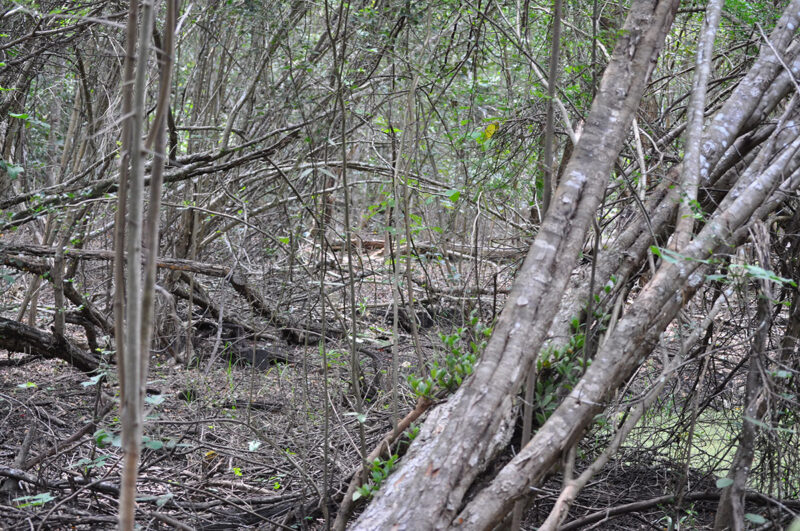
Campeche’s jungles are very thick and serve as home to many species of wildlife.
A few days before we arrived, a cave dug by the Mayans had been discovered right beside the ranch’s headquarters. Its recent discovery made me wonder what else might exist on the property. Ariel explained there were very few roads on the expansive ranch, “It’s ten to twenty miles between roads. No one goes into the areas between the roads. There’s no telling what is yet to be found or discovered including the animals which live there when someone does.”
No sooner had we left headquarters when one of our guides, Abelino, said to Miguel, our other guide, “El camino es largo, amigo!” I questioned Ariel, “Is he saying the road is a large one or a long one?”
Ariel smiled, “A long one!”
Weaving between huge vine covered trees we could occasionally hear and see howler monkeys. If you have never heard them roar, howler monkeys make a sound more like what one would expect to be made by a saber tooth tiger! Had Ariel not prepared me for what they sounded like, I am not so sure what I would have thought was making such a loud guttural sound…a yeti perhaps?
My brocket deer hunt had come about during a Coues whitetail hunt in Sonora, Mexico. It was there Ariel piqued my interest in brocket deer. He mentioned there were both gray/brown and red brocket deer species in Campeche; the latter being rarer and smaller in body and antlers. Red brocket deer weigh 20 pounds or less and are reddish in color. Big gray/brown brocket bucks weigh around 25 pounds. Males of both subspecies generally develop spike antlers. Rarely will there be a short brow tine. Ariel commented too, both are extremely secretive and difficult to take, even in Campeche where the populations of brocket are high.
Ariel explained the local jungle was also home to a small subspecies of whitetail deer, smaller than Coues whitetail. As we drove through the jungle, we also talked about the area’s many jaguar and puma. Based on tracks we saw while hunting, Rancho La Montana has a great abundance of both! Interestingly, we found huge jaguar tracks right behind our camp, five yards from our back door. About 200 yards from camp we found smaller jaguar tracks, likely made by a female. We saw many other big cat tracks while walking the jungle trails.
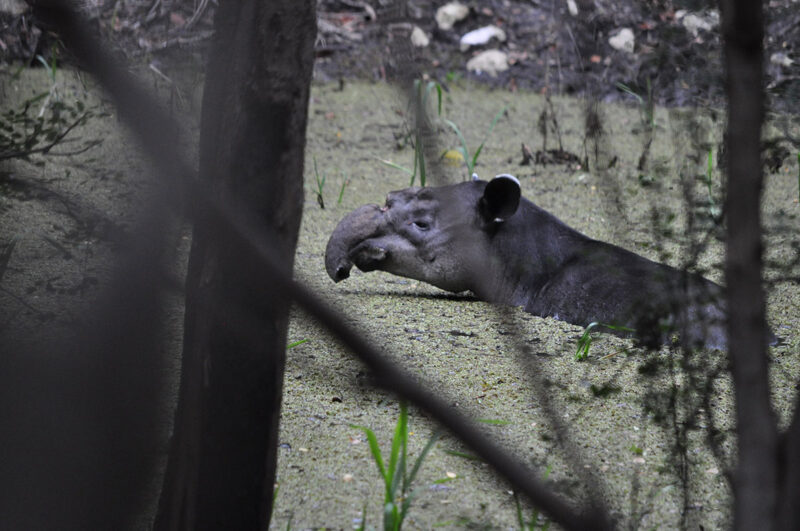
Rare tapir are found in considerable number in Campeche, as Larry observed.
We drove two hours before reaching the point where we started walking to the remote waterhole to spend the afternoon. I was hunting during the region’s “dry season,” a time when standing water is very limited. As we approached our machan, Miguel said, “Aqui tiene que llegar a tomar agua!” I too, hoped a brocket deer would come to drink this afternoon.
Thirty minutes into the afternoon’s sit we heard something walking on dry leaves. I turned and saw two large, dark, strange looking animals. One looked as if it weighed 150 pounds. The other was huge and weighed closer to 300. Both waded into the water. Had I not previously scanned books about the area’s unique wildlife, I might not have recognized them as tapirs; a rare, dark animal with the short trunk of an elephant, small round ears and a body that resembles a hog. We watched as they fed on vegetation growing in and near the water’s edge. An hour later, satiated, they drifted into the dense underbrush.
We spent the rest of the afternoon bird watching as the many different and colorful avian species kept us entertained. Unfortunately, no other four-footed animals showed. Needless to say, I was thrilled seeing tapirs. It was the first time I had ever seen that species outside of photos and a trip to the zoo.
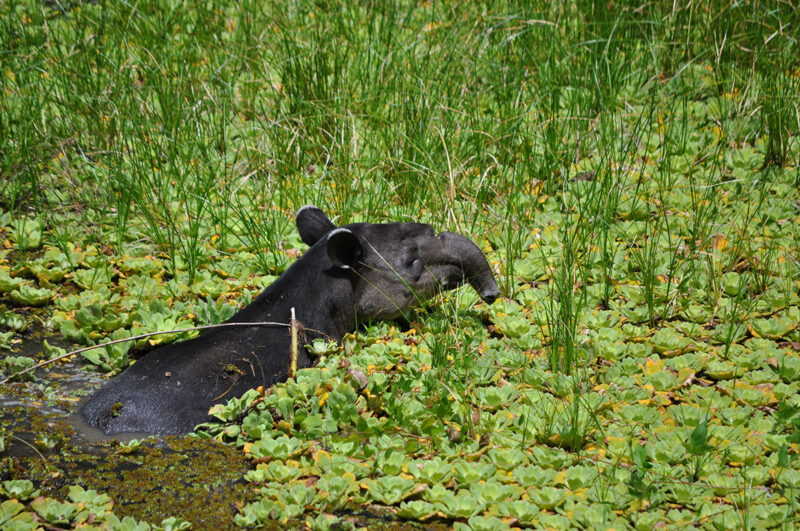
Another tapir!
The drive home in the dark was a long one, punctuated by several stops to fill the small gas tank to keep us going.
Back at camp around the fire…. Howler monkeys “roar” not unlike what I would expect a yeti to do and I said so again as we had iced drinks. One of our guides immediately got very quiet. Moments later he told a story he and others in our camp swore to be the truth. According to guide, two local hunters went into the deep jungle between the roads on the ranch. They hunted jaguar, using a traditional call made from a clay bowl and a long strand of wet rawhide, an olla. The sound made by sliding pinched fingers along the wet rawhide is supposed to sound like a jaguar and jaguars frequently come to such sounds.
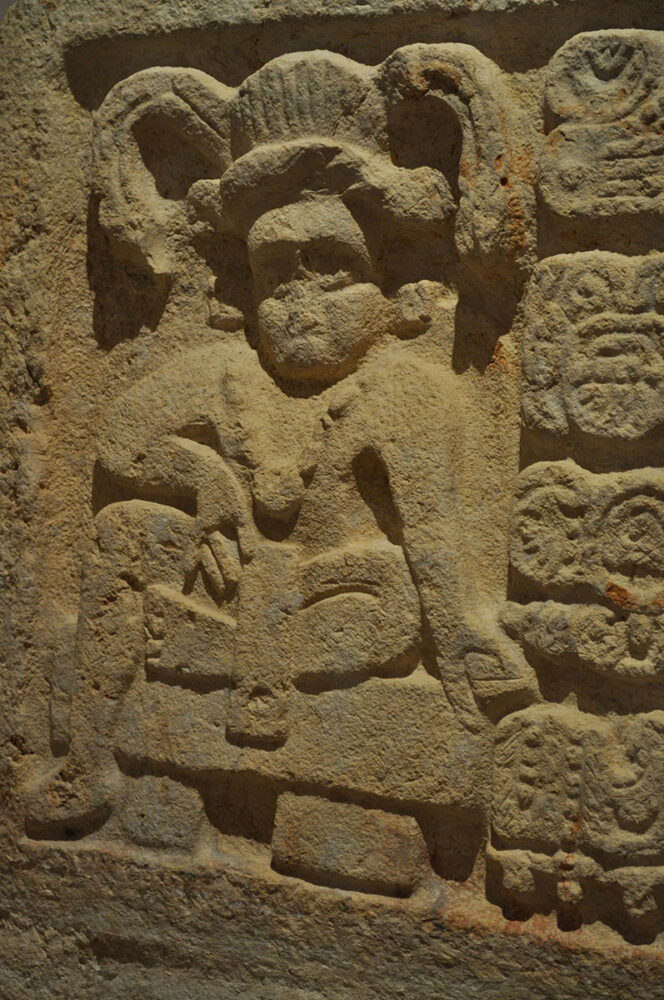
Relief carvings found on Mayan ruins near where Larry hunted brocket deer.
They had just started calling when something charged in running on two feet. Spooked, both men fired their shotguns. The charging critter went down. It was not until after they had shot that they realized the bipedal critter that lay at their feet was about 5 feet tall and covered with dark hair two to three-inches long. It had facial features not unlike a human, but, arms longer than most humans. They knew it was not any kind of monkey or ape! Uncertain what they had shot, the pair carried the hairy and smelly creature home to show to friends and family.
At camp, all who saw the “beast” were in awe. All proclaimed they had never seen anything like it. Some suggested perhaps it some sort of “humanoid,” not unlike what the people from the Far North called a yeti. Friends talked the two into taking the beast to the nearest village. The two loaded it into the back of their Jeep and headed to town. There, they showed the “thing” to numerous people. Upon seeing it, someone mentioned they had best leave town before the local police saw what they had shot. The law enforcement officers might think the hunters had killed an odd-looking human.
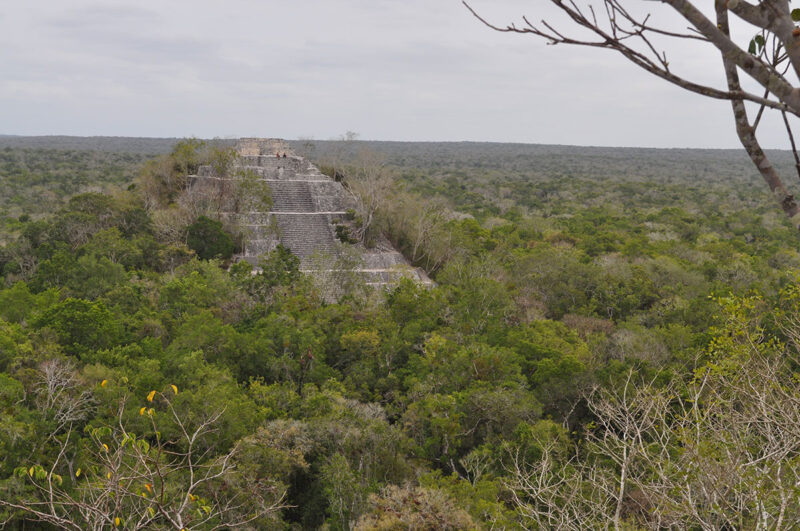
Campeche’s jungles were once the home of the Mayan civilization. Ruins such as this can be found throughout. Only a small number of the ruins have been excavated and explored.
The two hunters immediately left town and headed to the jungle. There they hid the body of what they had shot in a cave, then covered the entrance with rocks and vegetation.
The next day I asked Ariel to question our two guides if they knew anything about the mystery bipedal creature. Both turned pale and said in the local Spanish/Mayan dialect, “We do not speak of that thing….”
Who knows what strange things inhabit the jungles of Campeche or what mysteries might someday be solved there!

Campeche is home to many different bird species including the colorful oscillated turkey.
During our hunt we saw a great variety of birds including the brilliantly colored ocellated turkeys and many other large and small avian species. During the first days of the hunt, beside birds and tapir, we found tracks of brocket and also those of the diminutive whitetail previously mentioned, but saw no deer. Then things started changing. One morning we sat on top of a very high mound built by the Mayans. From our raised perch we saw six whitetail does and one female brocket, but, unfortunately nothing with antlers.
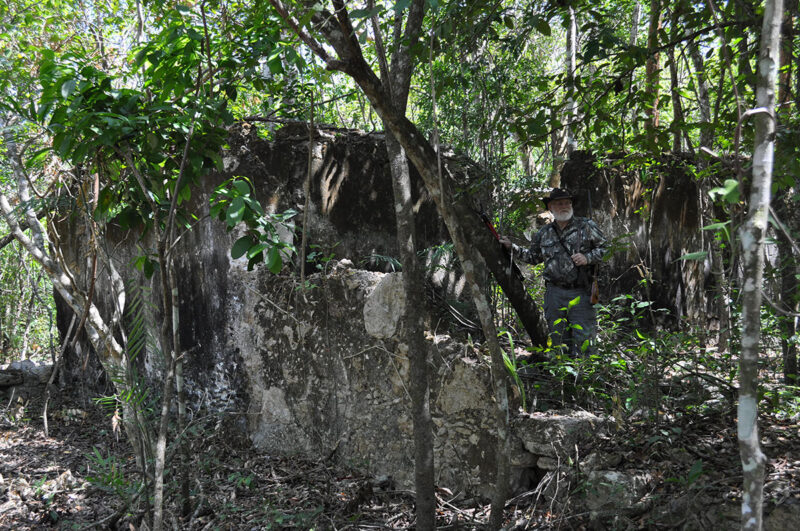
Larry hunted brocket deer in and around Mayan ruins.
Another day we hunted in and around Mayan ruins that covered many acres. This village included where those of long ago played ball games, where sometimes it is said they used an enemy’s head for their “ball,” and where the losing team was sometimes beheaded.
The day we hunted the Mayan ball field we had lunch and an early afternoon siesta near the ancient Spanish village of Patzahol. The settlement began during the days of Spanish exploration in the early 1500s. Interestingly, Patzahol continued as a thriving community until the early 1900s. Today the town has been abandoned and most of the buildings are in various states of ruin and being reclaimed by the jungle.
Later that day, as we walked a narrow trail, I heard Abelino say, “La selva esta muy densa, hay que tener cuidado de no perdernos!” I recognized enough words to understand the jungle was very dense and it would be seriously dangerous if we lost our way. I stayed close between Ariel and our guide. I hoped Abelino knew exactly where he was going and that once we got there, how to return to our vehicle.
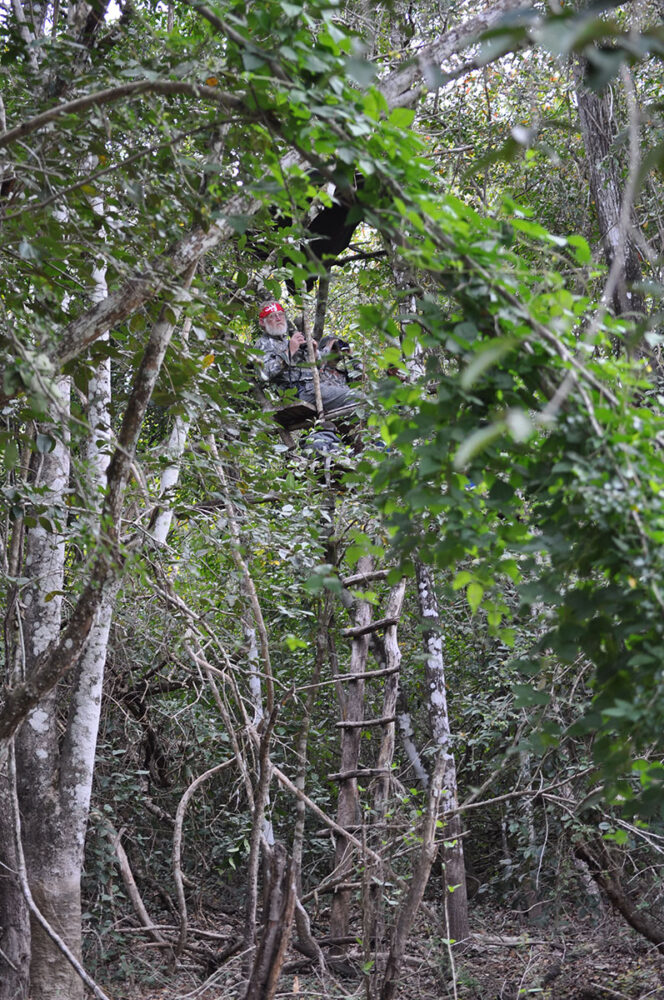
Larry hunted brocket deer in and around Mayan ruins.
Abelino pointed. Our destination was a machan, not unlike the early deer stands I hunted from when I was a youngster growing up in the Zimmerscheidt Community in the south-central part of Texas. We crawled up and got as comfortable as possible sitting on two narrow boards. A few minutes into our evening’s hunt, a tapir appeared, then a female brocket deer. The brocket deer drank then disappeared. The tapir kept us entertained all afternoon. As we watched the little female brocket, Ariel mentioned a friend of mine, Bob Foulkrod, had shot a nice brocket buck from this same machan three years earlier. I hoped I could do as well. Unfortunately, we did not see a buck that afternoon!
On the long drive back to camp we encountered a troop of howler monkeys. They expressed their displeasure rather loudly and adamantly! It’s amazing how such a relatively small monkey can make such a loud and intimidating roar!
“Tomorrow Miguel and Abelino will organize a deer drive for us. They’ll position us along a trail where they have found an abundance of brocket deer tracks. Then they will beat the bushes in hopes of pushing a brocket deer past us. Is that OK with you?” asked Ariel.
“I’m game, if they are!” I replied. “I dearly want to take a brocket deer while I’m here.”
The next morning over strong and highly sweetened coffee long before first light, we talked about what was about to happen. Our two guides, descendants of renown Mayan hunters, were picking up several of their friends. As soon as they returned, we would be positioned on the chosen trail. Then the drivers would start the slow push moving toward our position.
An hour later, our guides showed us where to stand and wait, then pointed the directions to watch. Ariel and Miguel remained at my side. Forty minutes later we could hear the beaters coming our way and I watched intently for any movement.
First came birds, then I spotted movement low to the ground running our way. It stopped behind a tree. “Temazate,” whispered Miguel. I had learned temazate meant brocket deer in the local dialect. Said Miguel softly, “Esta muy grande, tirale!”
I understood it was a buck and he had big antlers. I should shoot if I got a chance. I waited for a shot.
I had switched from a rifle to a 12-gauge shotgun loaded with No. 4 Buck. I saw movement just to my right. Coming out of the underbrush was the buck I had seen moments before, 25 yards away. How he got to there without my not seeing him, I will never know.
The fast-coming diminutive buck nearly ran into my left leg. He was so close I feared that if I shot, I would cut the little deer in half. He ran to my left and I waited for him to get 20 yards away before I pulled the trigger. At the shot, the buck went down. I reloaded and kept pointing the shotgun in his direction in case he tried to get up. He did not.
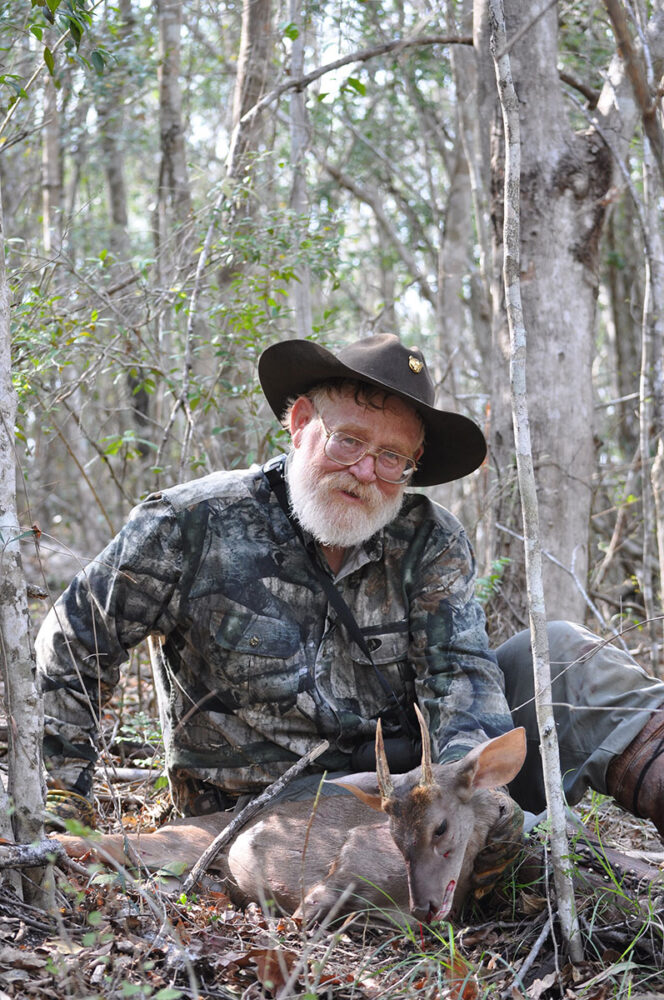
Larry Weishuhn shows off his brocket deer taken after numerous days of hunting.
Walking to brocket’s side I marveled at the handsome small deer. He was essentially equal in size to an 8-week old Texas whitetail fawn or steenbok I had previously hunted in Africa. I knelt at my buck’s side and picked up his head and rack. Both antlers were 5-inch long spikes. I said a prayer of thanks.
Being a wildlife biologist for many years got the better of me. I opened his mouth and looked at his teeth. Had he been a “regular” whitetail I would have guessed him to be a 6-year-old, definitely mature. I could not have been prouder than if I had just taken a Boone & Crockett record book qualifying “regular” whitetail. I was even prouder when I heard Miguel say, as I shook hands with him, “Felicidades, cazaste un buen trofeo!” Indeed, I truly was a happy hunter with my most excellent trophy!
Campeche holds many secrets. I seriously intend to some day return to its jungles to learn and explore and to again pursue brocket deer and other “ghost deer” that make it their home!
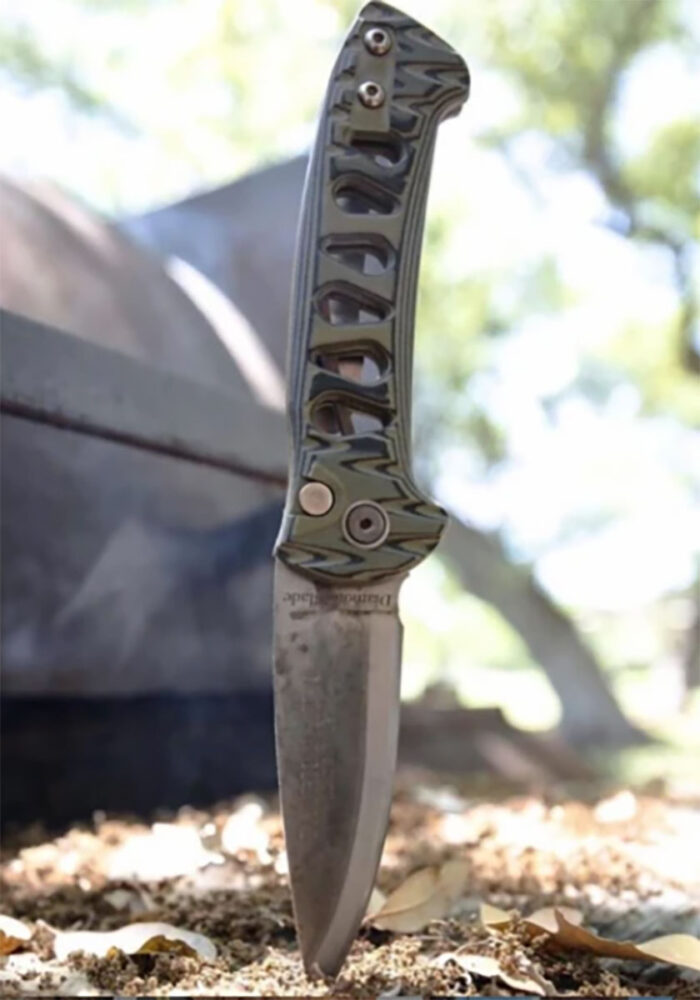 When you need to take care of business in a hurry, this push button automatic folding knife is a dependable tool by your side. The durable spring, made of 17-4 Stainless Steel* is lightening fast. The open handle with milled holes is lightweight and easy to clean, and the raised area on the spine features gimping for extra traction when bearing down. Buy Now
When you need to take care of business in a hurry, this push button automatic folding knife is a dependable tool by your side. The durable spring, made of 17-4 Stainless Steel* is lightening fast. The open handle with milled holes is lightweight and easy to clean, and the raised area on the spine features gimping for extra traction when bearing down. Buy Now

